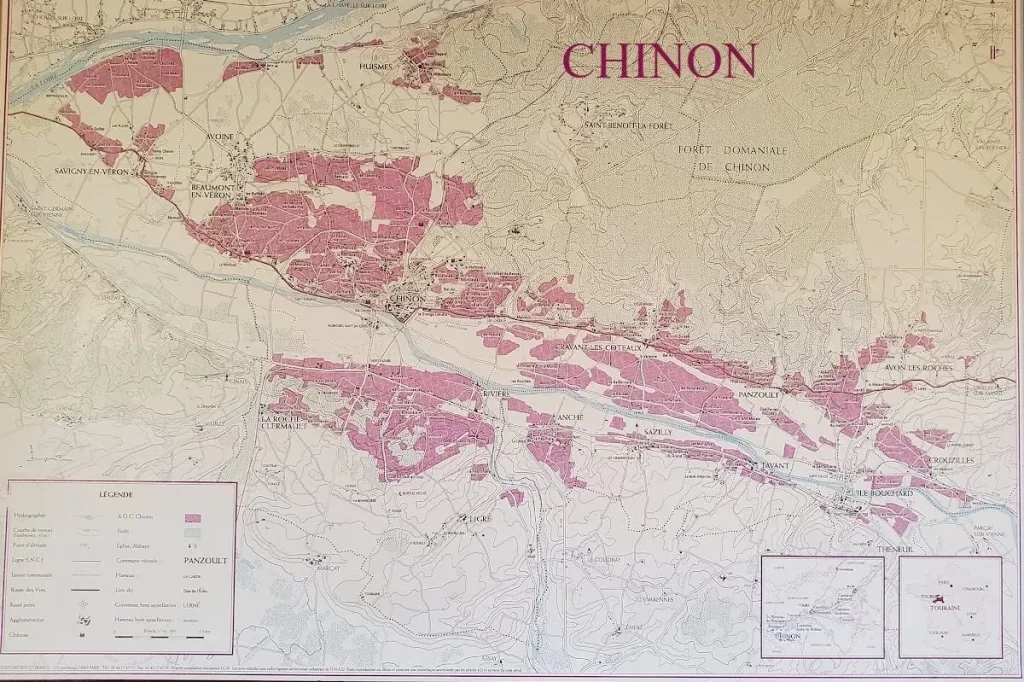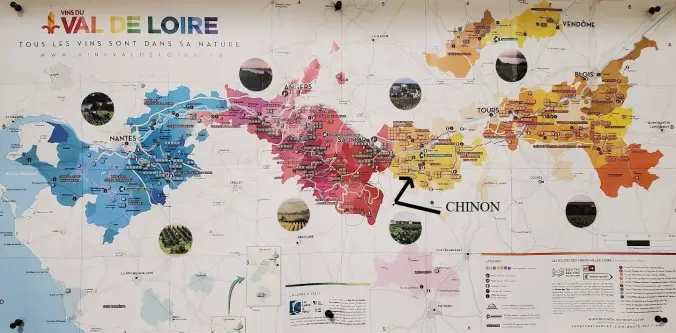Each time I visit a French wine region, I am astounded by the complexities of each appellation. For example, when I visited the Beaujolais in 2019, I discovered that within the region there are dozens of different appellations making red wine, each characterized by different grape growing elevations, yields, soil type, aging times, barrel types, and a myriad of other environmental and winemaking factors. The resulting wines are all so incredibly different, even though Beaujolais red wines are always, without fail, made from THE EXACT SAME GRAPE (gamay noir à jus blanc). It blows my mind how a single grape variety can produce so many diverse wines.
When visiting the Loire Valley last fall, I rediscovered this phenomenon in the appellation of Chinon, which makes single-varietal cabernet franc (red) or chenin blanc (white) in a panoply of different styles.

More than just a pretty medieval village, the town of Chinon is surrounded by vineyards. So every day I tried to visit at least one winery and taste their wares.

CHINON BLANC (chenin blanc)
The first domain I stopped at was Domaine Wilfred Rousse. There, I was astounded at the differences between two chenin blancs made by this producer. One was fresh and zippy while the other was round, oily and heavy, with richer flavours. “It’s the same grape!” I exclaimed. “How are they so different?” Wilfred’s wife, Annie, explained that the grapes simply came from two different vineyards. And while they were just a few kilometres apart, they each have distinct soil types, slope and elevation, all contributing different attributes to the chenin blanc. That, and a few differences in the winemaking process, of course.



Interestingly, white wines (always made from chenin blanc) only account for 4% of the wines produced in Chinon, which is why we rarely see Chinon Blanc on shelves on this side of the Atlantic.
Quick terminological side note
For anyone who may be confused by these remarkably similar terms…
CHINON: a wine appellation in the central Loire


CHINON BLANC: white wine produced in Chinon, always made from…
…CHENIN BLANC: white grape variety predominantly grown in the Loire (and in South Africa).
CHINON ROUGE (cabernet franc)
The Loire Valley is one of the only wine regions in France where single-varietal cabernet franc is made. It’s also grown in Bordeaux, where it is generally blended with merlot and/or cabernet sauvignon, providing floral notes and high acidityAcidity is an important part of a wine’s structure that prevents a wine from being “flabby”. It’s what gives you that tingling sensation on your tongue and makes you salivate.... More to these full-bodied wines.
However, the Loire Valley is a cool-climate winegrowing area, so the cab franc wines produced there tend to be slightly lighter-bodied, with bright berry flavours and lighter tanninsTannins help form a wine’s structure, but generally only in red wines. Tannins come from the grape’s stems, seeds and skins, and to a lesser extent from the wood in... More than their warm-climate counterparts. Cabernet franc can also be a divisive grape—you either love it or you hate it. For me, given its naturally medium-high tanninsTannins help form a wine’s structure, but generally only in red wines. Tannins come from the grape’s stems, seeds and skins, and to a lesser extent from the wood in... More, cab franc makes great food wines, but can be tough to drink on their own. But this is why Chinon wines are incredibly age-able.
I definitely struggled to appreciate some of the cab francs I tried on my trip – I found that their tanninsTannins help form a wine’s structure, but generally only in red wines. Tannins come from the grape’s stems, seeds and skins, and to a lesser extent from the wood in... More overpowered their flavours, which is why I always felt that they needed food (or a few more years in the cellar) to be properly enjoyed. That was, until I visited Domaine Olga Raffault.
Domaine Olga Raffault
I started by sampling some whites (chenin blanc, of course). The fresh 2022 Champ-Chenin would be a perfect seafood platter pairing, with its light, exotic fruit flavours balanced by crisp minerality and acidityAcidity is an important part of a wine’s structure that prevents a wine from being “flabby”. It’s what gives you that tingling sensation on your tongue and makes you salivate.... More. Then I tried the slightly oaked L’Or d’Olga, which was a completely different beast. The crisp acidityAcidity is an important part of a wine’s structure that prevents a wine from being “flabby”. It’s what gives you that tingling sensation on your tongue and makes you salivate.... More was still there, but the mouthfeel was much rounder, almost viscous, with subtle notes of vanilla from being aged on its leesDead yeast cells! No seriously. After yeast has fermented a wine's natural sugars, it forms a sediment called the lees. Sometimes winemakers will leave the wine on its lees ("sur... More for a year in older oak barrels.
But the cabernet francs were the real show stoppers here. I tasted three of them, ranging from young and fresh to the age-worthy La Singulière.

First up was La Fraîch’ (I assume short for “la fraîcheur” for its freshness). The first thing I noticed was the simple beauty of the watercolour-like label artwork, setting the scene nicely for the bottle’s contents: light-bodied with medium tanninsTannins help form a wine’s structure, but generally only in red wines. Tannins come from the grape’s stems, seeds and skins, and to a lesser extent from the wood in... More and acidityAcidity is an important part of a wine’s structure that prevents a wine from being “flabby”. It’s what gives you that tingling sensation on your tongue and makes you salivate.... More, but so tasty I had to remind myself I couldn’t drink it all because it was only 10:30 in the morning. The wine’s bright, red cherry and blackberry flavours only revealed a hint of the telltale green pepper notes that make cab franc so recognizable. While quite easy to drink all on its own, it would pair perfectly with a cheese plate or a ploughman’s lunch with terrine and pâté.

We then moved on to the 2018 Les Picasses, which was heavy on the black cherry and cacao from being aged in large barrels. But then my host Sylvie, whom I later learned is Olga’s granddaughter, had me taste La Singulière. Made with grapes from some of their oldest vines, this wine is aged for two to three years in small barrels, imparting a lusciously silky mouthfeel and solid tanninsTannins help form a wine’s structure, but generally only in red wines. Tannins come from the grape’s stems, seeds and skins, and to a lesser extent from the wood in... More, making this a wine that can be aged for at least a decade.

All the grapes at this fifth-generation winery are picked by hand, as is typical of small family vineyards. The winery is also among the 45% of wineries in the Chinon appellation that are certified organic.
TL;DR
While I was already a fan of chenin blanc, these Chinon wines totally changed my mind about cabernet franc, and every day I kicked myself for flying carry-on only, because it meant not being able to bring bottles home in my suitcase.
But my four days in Chinon really impressed upon me how versatile both chenin blanc and cabernet franc can be, not to mention their aging capability, and I now keep an eye out for both when perusing the aisles of the wine store.
Speaking of wine stores, Chinon is not always easy to find in my neck of the woods, i.e. there is only a small selection available at the LCBO or the SAQ (though the latter has a much more interesting selection).

Tasty cab francs you can get your hands on without going to France:
- Domaine de la Butte Bourgueil: This wine put Loire Valley cab franc on the map for me, after tasting it at Véronique Rivest’s Assoiffés wine festival a few years back. This wine is produced by Jacky Blot, who is a very well-known producer in France. You can occasionally find it at the SAQ, or get it directly from the Quebec agency Vini Vins.
- Domaine Olga Raffault is represented in Ontario by Vintage Selector and in Quebec by Divine Sélection.
I’m off to Montréal this week to attend a panel discussion on the wines of the Central Loire. Stay tuned for more on the delicious wines from this fabulous wine region!
In the meantime, (very) belated happy new year and happy wining!




Hey Chris and Kelly!
Yes, tannins essentially preserve the wine in the bottle, so wines with higher tannins tend to be more “age-worthy”. And your assumption is correct – tannins break down over time so that the wine mellows.
I actually have a whole post about decanting that I wrote during Covid! Hopefully you’ll find the answers to all your decanting questions here: https://winingwithmel.com/decant-aerate/
Hey Mel. Really enjoyed this post as we sail north. Keep em coming! Will see if we can find any of these back in the states (if anything is left when we get there).
Newbie Q: You mention strong tannins and acidic as reasons for aging cabs. I assume aging mellows. What are your recommendations for decanting? When to recognize, etc? Thanks again!